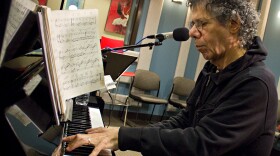This feature is derived from KNKX's Tree of Jazz, taking you through the eras, from the roots to the new budding leaves, with a weekly deep dive into iconic artists, albums, and instruments.
Sixty years ago, celebrated trumpeter Lee Morgan stepped into the studio with a band of Blue Note Records all-stars for a session that became Cornbread. On the album, we hear Morgan branching out beyond the bright horn lines and feel-good grooves that brought him and Blue Note Records great success. The music also captures the tension between commerce and creativity that influenced both the trumpeter and the label in the mid-1960s.
At the time of Cornbread's release, Morgan was 27 but had already been playing professionally for nearly a decade. He joined Art Blakey and the Jazz Messengers in 1958 at just 18 years-old, part of a congregation of top-notch Philadelphians who were moving jazz forward sonically. With Blakey, Morgan further developed his playing and composing skills, and by the mid-1960s, he was a full-fledged jazz star.
After leaving the Messengers, Morgan recorded prolifically on Blue Note, including his most recognizable and grooving hit, The Sidewinder. The record’s bopping horn lines and rhythm made it an instant crossover success in 1964. It is also credited with giving the struggling label a much-needed financial boost.
Shortly after recording The Sidewinder, Morgan had laid down something strikingly different: Search for the New Land, a rousing and contemplative suite that presented a desire to explore new creativity in his music and explored his feelings as a Black man in the turbulent 1960s, as implied in I Called Him Morgan, a 2016 documentary about Morgan's life.
Search for the New Land was recorded in 1964 but shelved until 1966. Instead, Blue Note sought to replicate the success of The Sidewinder in 1965 with Cornbread.
Sonically, Cornbread lands somewhere in between The Sidewinder’s commerciality and Search for the New Land’s innovation and contemplation. The title track and “Most Like Lee,” roll out with the energy of The Sidewinder, and the tender bossa nova, “Ceora,” shines with lyrical horn lines and easy-going rhythm. “Ceora” has become one of Morgan’s most accessible and enduring standards.
In contrast, there’s the track “Our Man Higgins,” an adventurous showcase for the incredible drummer Billy Higgins, who also elevated the energy of The Sidewinder. Higgins breaks loose in between horn phrases that ascend and descend in unexpected ways, making the chorus feel more like a car chase than a stroll through the park. From there, Higgins' fiery solos are boisterous, but his mighty bursts of rhythm never overtake the tune.
“Ill Wind” rounds out the session with a more contemplative mood, another reminder of Morgan’s range and a look into the mindset of the trumpeter and the band at the time. Though the track is entirely instrumental, the lyrics of the song, written in 1934 by Ted Koehler, are poignant: “Ill wind blow away, and let me rest today…”
The pensive, searching mood on some of Cornbread’s tracks may have also stemmed from the tumultuous era. The year of Cornbread’s recording,1965, included the assassination of Malcolm X, with whom Morgan was said to have identified, as well as the Vietnam War, and a series of historic protests in the fight to pass the Voting Rights Act.
In the years after Cornbread, Morgan became more politically involved, joined the anti-racist Jazz and People’s Movement, and he became more outspoken about genre labels and artistic identity, too. In particular, he began to reject the musical classification of “jazz” as imposed, not chosen.
“I don’t even like the word ‘jazz,’ really. I think it’s a bad word. It’s not a word that we made up. Just like we were told that we are Negroes,” he said in footage included in I Called Him Morgan.
Listening today, Cornbread is one of Morgan’s most lasting statements, whether it’s the easy grooves or the moments he reached for something more. The record asserts that, even amidst troubling times, there’s room to sit back with easy grooves and to stretch one's creativity.
This story comes from the Sept. 14, 2025 episode of the Tree of Jazz. Listen to the past two weeks of Tree of Jazz On-Demand and hear deep dives like this each week on the Tree of Jazz, on air and online every Sunday from 3-6 p.m. PT.








